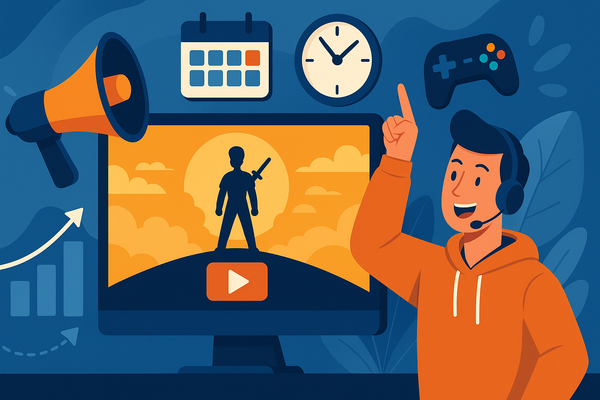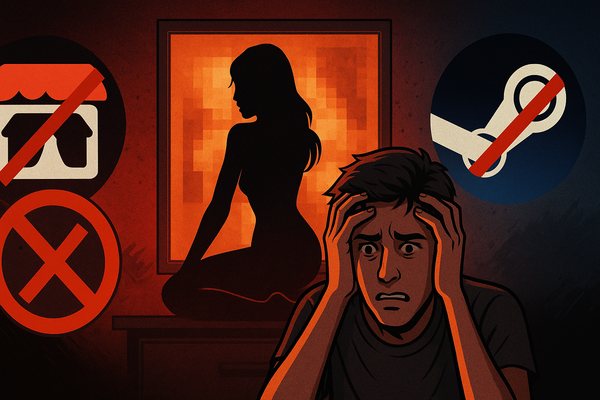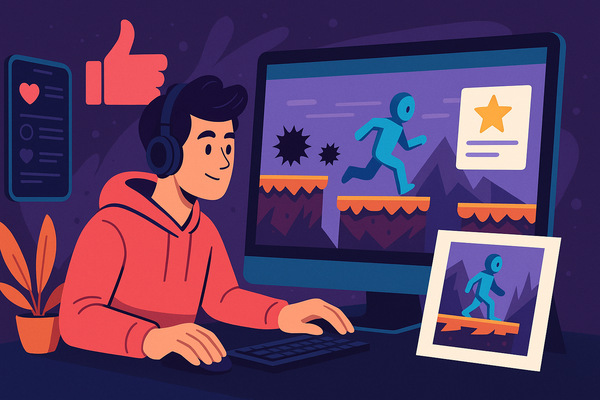How To Prepare for NextFest - 2025 Game Marketing Guide
Learn how to maximize Steam NextFest success with data-driven strategies. Get 3-month preparation timeline, wishlist optimization tactics, influencer outreach, social media marketing & conversion benchmarks. 2000+ demos compete - discover why pre-event momentum is crucial for indie game success.
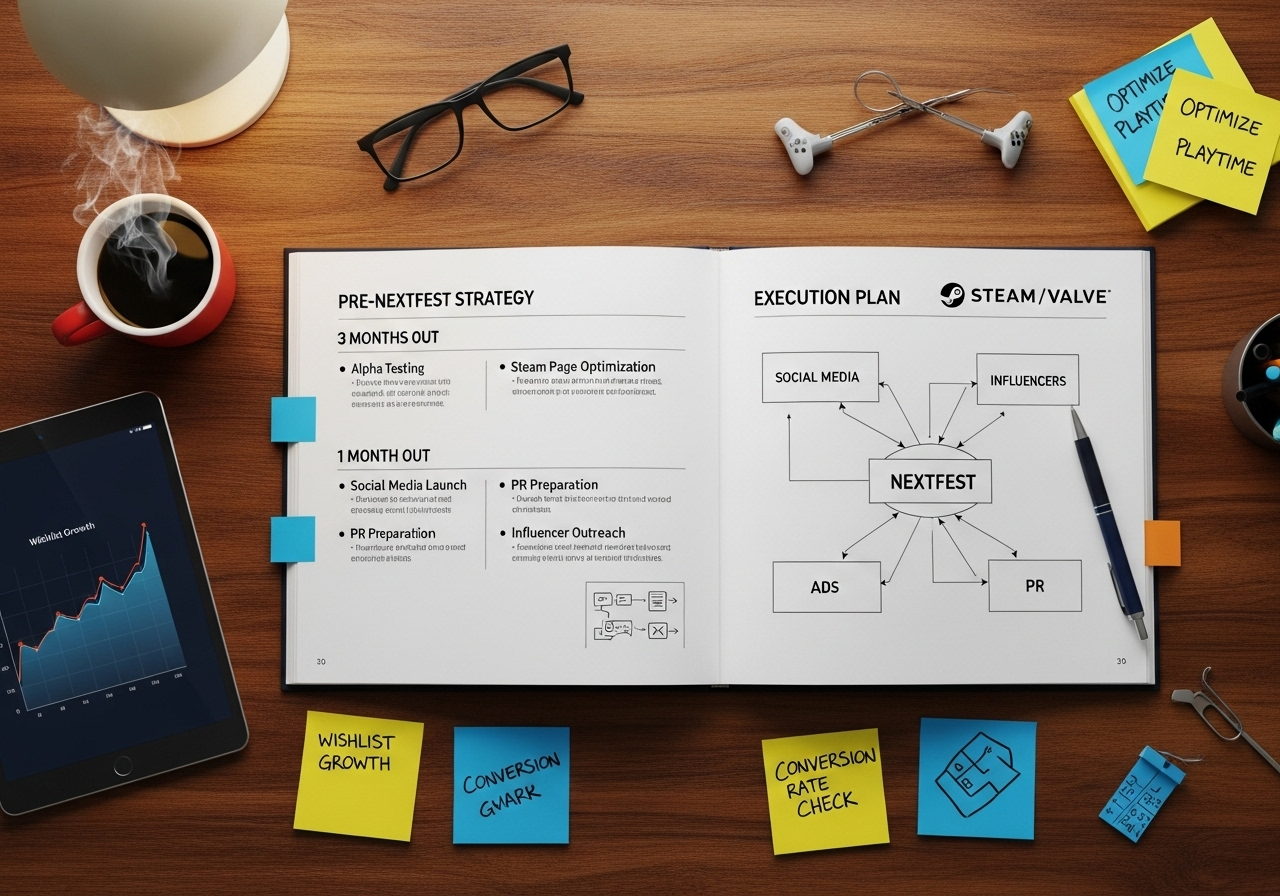
NextFest is coming again! This October 13, 2025, with the next one coming, presents a crucial opportunity for games to showcase themselves and gain wishlists. Many games use this event as a launch pad for their title or as the final push before launching in the fall. However, the requirements to be successful in NextFest have changed dramatically with the sheer volume of games entering this hallmark festival.
To successfully prepare for NextFest, you should plan and execute your strategy at least 3 months in advance to maximize your wishlist outcome. In this article, we are going to discuss:
- The current state of NextFest and its competition
- Median Playtime and Its Effect On The Algorithm
- Steam Page Optimization
- Using Influencers To Promote Your Game
- Social Media and NextFest
- Using Ads To Grow Your Wishlists for NextFest
- PR And NextFest
- A Unified Strategy
The Current State Of NextFest and Why NOT To Launch Then
First, we need to understand the current state of NextFest, how it has evolved, and what the expected results are. As one developer pointed out on BlueSky, the submissions and launches to NextFest have skyrocketed.
So... Steam Next Fest happened again, and the number of folks that have been disappointed by their game's performance seems to be growing higher and higher. I looked at the number of demos launched on Steam in the window of each Next Fest the past five years, and.... 🤯
— Chris Hanney (@hanney.bsky.social) 2025-06-17T07:30:18.512Z
As the graph shows, back in 2019, 250 demos were launching during NextFest. In 2025, over 2,000 demos launched during NextFest. The competition has become significantly more fierce. Naturally, you would think that more demos being launched means fewer players per game.
Chris Zukowski, Game Marketer and Analytics expert, conducted his own report here from his community at "How To Market a Game" and found that in the article he published, the games that performed well were the ones that had traction prior to NextFest.
Pre-NextFest Wishlists Performance Data:
| Pre-SNF Wishlists | Median Earned | % Increase |
|---|---|---|
| 0–999 | 462 | 150% |
| 1,000–9,999 | 1,513 | 45% |
| 10K–99K | 6,360 | 28% |
| 100K+ | 23,731 | 13% |
From a data-driven approach, this all boils down to one very important insight for your game: do not launch your game at NextFest simply because it exists—the competition is highly saturated. You need to be generating wishlists prior to NextFest to maximize your outcome. The data clearly shows that games with existing momentum see the highest percentage gains, making pre-festival preparation absolutely critical.
How do you prepare for NextFest? There are several effective approaches to consider.
Median Playtime Influences On NextFest
While I would NOT recommend launching your demo specifically at NextFest, but if you must, then I would strongly recommend conducting Alpha Testing beforehand. During this stage, watch for one critical factor: playtime.
Steam uses playtime as a key metric for curation, because playtime is a strong predictor of whether the masses might enjoy your game. Valve (Steam's parent company) published a detailed video explaining this concept:
While the video is comprehensive, they have a direct quote in their presentation that states:
"When players spend time and money on your game, it's a strong signal to Steam that it could be interesting to other players, too."
If your playtime data looks problematic with your current demo or alpha tests, you're likely to not have your game promoted by Steam's algorithm. The algorithm favors games that demonstrate strong player engagement through extended play sessions.
Game marketer Erik Kovac of Tilt Games pointed out in his LinkedIn post what a healthy engagement curve looks like when players are truly engaged with a game. The data should show players spending meaningful time in your game rather than dropping off quickly.
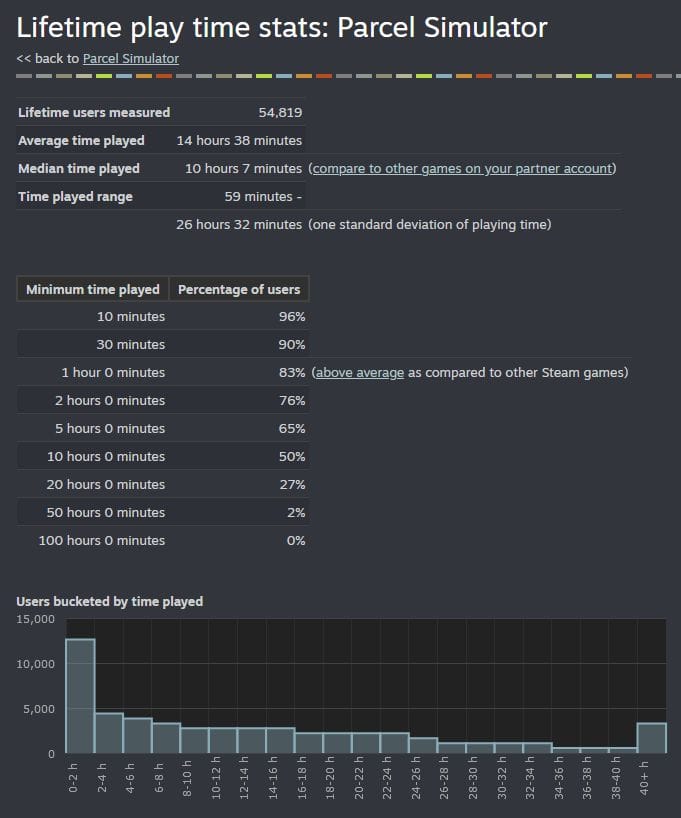
If your demo is already live and your playtime metrics are low, prioritize improving player retention. If your demo isn't released yet, conduct alpha testing to understand your playtime patterns. Focus on these critical aspects:
- Analytics Setup: Do you have analytics configured in your onboarding process that track how users funnel into your game? Understanding where players drop off is crucial for optimization.
- Onboarding Process: Do you have an onboarding experience that correctly introduces players to your game in an engaging way? Do they learn all the essential game mechanics needed to begin playing effectively?
- Bug-Free Experience: Is your game mostly free of critical bugs? How are you tracking bugs, and are you keeping players updated on bug fixes and improvements?
- Community Relationship: Have you begun building relationships with players through your social media channels, Discord community, or other communication methods?
If you're conducting Alpha tests, you should start this process at least 3 months out. Work backwards from how long it typically takes you to recruit players, analyze their gameplay results, gather direct feedback, implement fixes, and then conduct another test cycle to ensure the issues you identified are resolved and no new problems have emerged.
Steam Page Optimization
Is your Steam page optimized for converting visitors into wishlists? There are several critical elements to examine here. The first is localization—making your Steam page available in multiple languages. In fact, Valve has pointed out that localization is critical in how their algorithms choose what content to show to different regional audiences.
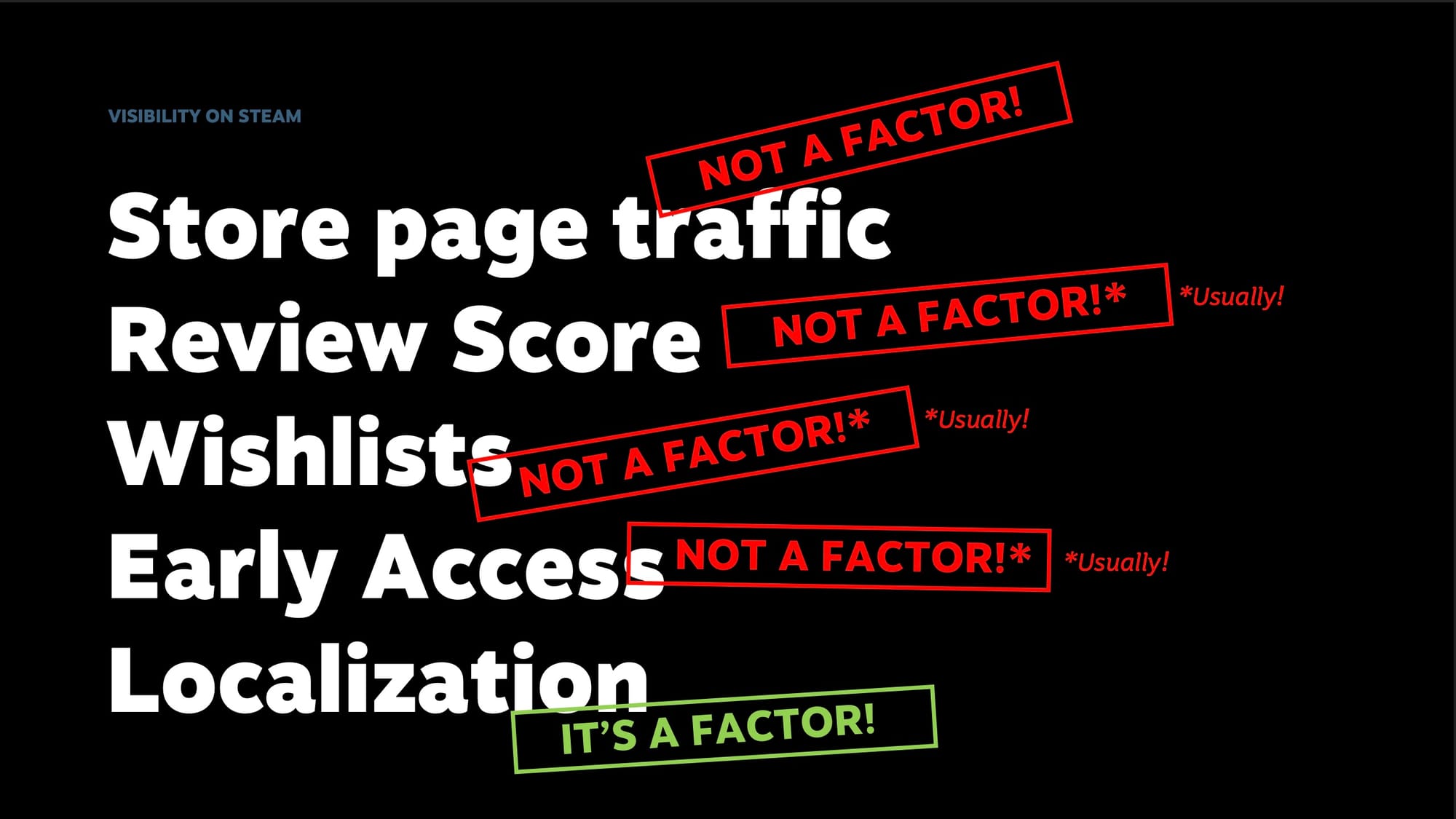
Another excellent resource for Steam storefront optimization is Chris Zukowski's comprehensive course on Steam page optimization. It's a detailed guide covering all the optimization techniques not fully covered in this article, and we strongly suggest you work through it systematically.
After you have fully optimized your store front, you need to measure whether it's correctly converting visitors. To do this, access your Steam Dashboard and examine two key metrics: how many unique visits you've received to your game's page, and how many people have added your game to their wishlist.
The formula for measuring your conversion rate is:
(Number of Wishlists Added / Unique Store Page Visitors) × 100
For example, if 2,000 people visit your page and 150 add it to their wishlist: (150 / 2,000) × 100 = 7.5%
Conversion Rate Benchmarks:
- Less than 5%: Your store page is poorly optimized and needs significant work
- 5% to 15%: You're in the average range of conversions
- Above 15%: Your Steam storefront is converting exceptionally well!
Analyze your numbers to determine where your conversion rate falls, and decide whether optimization is necessary. Starting this process early (we recommend 3 months in advance) gives you ample time to test different approaches, optimize based on results, and continuously improve. Next, let's discuss driving traffic to your optimized page through influencers, social media, advertising, and PR.
Influencers
Many developers want influencers to play their games during NextFest to increase their game's ranking and visibility. There are multiple strategic approaches to consider:
- Pre-NextFest Strategy: Since it's been established that games entering NextFest with prior traction perform better, you can use influencers to gain wishlists before the event
- During NextFest Strategy: Have influencers play your game during NextFest to drive your ranking within the festival
- Combined Approach: Execute both strategies for maximum impact
Regardless of your approach, influencers require significant lead time to source and execute partnerships with. We published a detailed article about understanding timelines in game marketing, and we strongly recommend working backwards from your target dates when planning.
Here's a condensed timeline of what it takes to secure influencers:
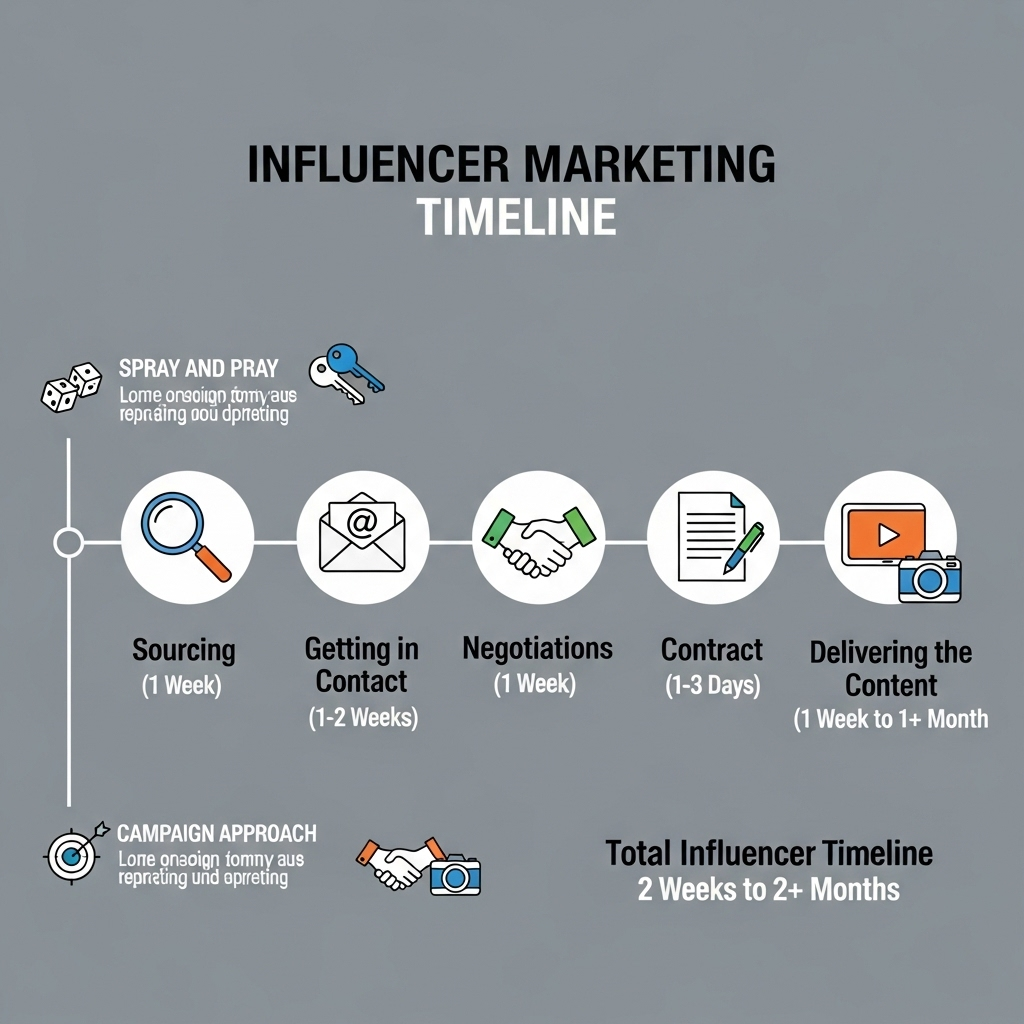
1. Sourcing (1 Week)
- Identify and shortlist relevant influencers
- Decide between broad appeal (e.g., major streamers like Ninja) vs. niche alignment with your game's genre
- Build a comprehensive contact list (200–300 contacts for spray-and-pray approach, ~100 for targeted campaigns)
2. Getting in Contact (1–2 Weeks)
- Send initial outreach emails with compelling pitches
- Follow up consistently (usually takes 2–3 touches to get a reply)
- Account for varying influencer response times
3. Negotiations (1 Week)
- Discuss compensation, deliverables, and timelines
- Navigate more complex negotiations when managers or agents are involved
- Lock in budget discussions and content scope
4. Contract Finalization (1–3 Days)
- Draft and sign formal agreements
- Handle any redlining or contract revisions that may occur
5. Content Delivery (1 Week – 1+ Month)
- Livestreams: Coordinate with influencer schedules for optimal timing
- Videos: Expect 2–3 weeks for quality production and editing
- Timelines vary significantly based on influencer size and content complexity
This means that if NextFest is October 13th and you want to properly secure influencers to play your game during NextFest, you need to start sourcing them by September 13th at the latest. If you want influencers to play your game and build wishlists prior to NextFest, start the sourcing process in early August to allow for the full pipeline.
Social Media Marketing
Social media marketing is incredibly influential when it comes to driving wishlists, even when your follower count is minimal. We've worked with developers who had only 300 followers total across TikTok, X/Twitter, Instagram, BlueSky, and YouTube, and managed to generate 20 wishlists per day through consistent, strategic content!
With social media, daily wishlist growth is the key metric to focus on. Think about the compound effect:
Small Account Example (300 total followers):
- You're generating 20 wishlists per day from social media
- 20 per day × 30 days = 600 per month
- 600 per month × 3 months = 1,800 wishlists
If you reference Chris Zukowski's chart above, you would probably earn around 1,500 wishlists from NextFest itself. This illustrates why starting your social media efforts months earlier allows you to build momentum and leverage a proven process that accelerates your wishlist growth. It's a compounding effect, detailed in this short video here:
Larger Account Example (10K+ followers across platforms): Some of the most successful games we've worked with have been able to drive 100 wishlists per day on average through a comprehensive social strategy. This typically occurs when they've reached at least the 10K follower mark across all platforms combined. The math becomes compelling:
- You're generating 100 wishlists per day from social media
- 100 per day × 30 days = 3,000 per month
- 3,000 per month × 3 months = 9,000 wishlists
- They would probably earn around 5,000+ wishlists from NextFest
If you want to dive deeper into developing a social media strategy, read our comprehensive blog article about the 7 Key Factors of Social Media Marketing for game developers.
Paid Acquisition (Ads)
Now we can move onto paid acquisition for wishlists—essentially, advertising. Ads represent a common and scalable way of bolstering your wishlists, though unlike working with nano influencers and organic social media (which you can execute for free), advertising requires a financial investment. However, for that cost, you can scale your growth with significantly less manual effort.
Paid acquisition success comes down to understanding your Cost Per Wishlist for your specific game. The formula is:
Cost per Wishlist = Total Spend / Number of Wishlists Gained
Let's examine some examples with a $100 spend:
- If you gained 100 wishlists: $100 / 100 = $1.00 per wishlist
- If you gained 50 wishlists: $100 / 50 = $2.00 per wishlist
- If you gained 20 wishlists: $100 / 20 = $5.00 per wishlist
Similar to the influencer strategy, you can approach paid acquisition with multiple strategic frameworks:
- Pre-NextFest Strategy: Use paid acquisition to grow your wishlist count before NextFest and let the festival momentum carry the rest
- During NextFest Strategy: Increase your ad spend during NextFest to help promote your game at a higher level during the festival to gain more wishlists
- Combined Approach: Execute both strategies for maximum impact
Let's examine a practical scenario:
Example Campaign:
- You spend $300 per month on advertising
- Your cost per wishlist is $0.50
- $300 / $0.50 = 600 wishlists per month
- 3 months of this strategy = 1,800 wishlists before NextFest
- With this foundation, you'd be positioned to earn another 1,500+ wishlists from Steam's NextFest promotion
If you plan to use advertising to grow your wishlists, determine your monthly advertising budget and target cost per wishlist, then work backwards to calculate how many wishlists you want to accumulate before entering NextFest.
PR/Journalism
Finally, we reach PR—getting journalists, bloggers, or publications to write about your game in relation to NextFest. We've spoken directly with journalists, and they've reported receiving over 800 press kits in the week leading up to NextFest alone. That represents incredibly heavy competition!
Don't get caught up with everyone else sending their press releases at the last minute. Start your PR outreach 1 to 2 months prior to NextFest:
- Curate a targeted list of journalists and publications you want to write about your game for NextFest
- Craft tailored, personalized emails for each contact rather than using generic templates
- Begin sending outreach to your curated list with compelling, newsworthy angles
- Follow up consistently several times if you don't receive an initial response
The key to successful PR is standing out from the flood of generic pitches by offering unique angles, exclusive access, or compelling stories that journalists actually want to cover.
Unified NextFest Launch Plan
To truly maximize your success at NextFest, combine multiple marketing strategies to drive wishlist growth rather than relying on just one approach. A comprehensive, integrated plan utilizing everything together might look like this:
3 Months Out (Target: 800 wishlists)
- Demo/Alpha Testing: If you don't have a demo released yet, start conducting alpha tests. If you already have a demo live, ensure your median playtime metrics are strong and optimized.
- Steam Page Optimization: Begin optimizing your Steam page to maximize conversion rates from visitors to wishlists.
- Social Media Launch: Begin executing your social media strategy (targeting 600 wishlists per month through consistent content).
- Paid Acquisition Start: Invest $100 into ads; at $0.50 per wishlist, that generates 200 wishlists.
2 Months Out (Target: 800 additional wishlists)
- PR Preparation: Assemble your press kit for publications and begin reaching out to relevant journalists and bloggers.
- Continued Alpha Testing: If still in alpha phase, conduct another round of testing and address player feedback issues identified in the first alpha.
- Social Media Continuation: Continue your social media strategy (600 wishlists per month).
- Sustained Ad Spend: Continue investing $100 into ads at $0.50 per wishlist for another 200 wishlists.
1 Month Out (Target: 1,800 additional wishlists)
- PR Final Push: Make your final push to journalists with compelling, timely pitches.
- Influencer Outreach: Reach out to influencers about streaming your game during the festival (targeting 1,000 wishlists from influencer coverage).
- Social Media Intensification: Continue your social media strategy (600 wishlists per month).
- Maintained Ad Investment: Continue with $100 in ads at $0.50 per wishlist for 200 wishlists.
Total Projected Results: Within 3 months, you accumulate: 800 + 800 + 1,800 = 3,400 wishlists before NextFest
With the median NextFest performance at 1,634 additional wishlists, you could reach 5,000+ total wishlists by the end of the event. More importantly, you now have a proven, repeatable growth strategy that you can continue executing beyond NextFest for sustained long-term success.
Tools to Help You Succeed
Marketing is time-consuming and can be challenging to execute while simultaneously developing your game. At Glitch, we offer a variety of tools designed to help you automate these processes, allowing you to maintain marketing momentum while focusing on development.
Influencer Tools: We offer both a free influencer database and a specialized tool that sources influencers who play games similar to yours, making targeting much more precise and effective.
Social Media Automation: On Glitch, we provide social media automation tools, including an AI system that searches relevant subreddits for your game's genre, analyzes each community's posting rules, and provides optimal posting strategies you can execute without getting banned from subreddits. You can also cross promote with other developers during the festival.
Advertising Management: We offer a unified dashboard that allows you to manage all advertising platforms under one interface and conduct comparative analytics across different ad networks to optimize your spending efficiency.
Time To Prepare
NextFest has evolved from a modest showcase of 250 games to a massive competitive arena featuring over 2,000 demos. The days of simply showing up and hoping for organic discovery are over. Success now requires strategic preparation, sustained effort, and a multi-channel approach that begins months before the event.
The data is clear: games that enter NextFest with existing momentum dramatically outperform those starting from zero. A game with under 1,000 pre-event wishlists can expect a 150% increase, while those with 100K+ wishlists see only a 13% bump. This isn't a failure of the festival—it's the natural result of Steam's algorithm favoring games that already demonstrate player engagement and interest.
Your three-month preparation timeline isn't just a suggestion; it's a necessity in today's competitive landscape. Whether you're conducting alpha tests to optimize playtime, building social media momentum, negotiating with influencers, or fine-tuning your Steam page conversion rates, each element requires adequate time to execute properly and show results.

